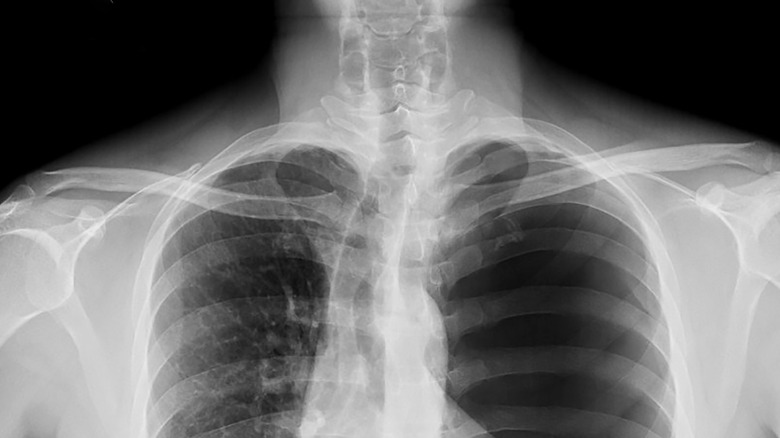Artificial Windpipe Spells Doom For Dr. Paolo Macchiarini's Patients
Those who have been following the story of renowned physician Dr. Paolo Macchiarini may have a case of whiplash.
In 2011, Macchiarini immediately ascended into fame after he developed an artificial medical device that had the potential to save thousands of lives, according to The New York Times. More than a decade later, he is in headlines again. This time, it's for being handed down a suspended sentence in court for his medical work (per The New York Times). What followed in between was a tale involving an engagement with a news reporter, a promised officiation from The Pope, and a mysterious "V.I.P club" cover story.
A bonafide conman, Macchiarini seems to have built up an empire of deceit that has finally been taken down. Here's the story of the Swiss-Italian doctor and his work that landed him in court.
The first 'bioartificial windpipe'
The medical device Macchiarini invented was "the world's first 'bioartificial' windpipe," per The New York Times. Essentially a plastic replica of the trachea, this device could be individualized because it had been "soaked in the patient's stem cells." The idea was that the stem cells would naturally regenerate and seamlessly adapt to the rest of the body's processes, letting the body do the work rather than relying on heavy machinery like artificial hearts that are still sometimes used for patients on the waitlist (via The New York Times). Ideally, it could decrease the rate of transplanted organ rejection.
The invention seemed to be a major breakthrough in the field of regenerative medicine, as it showed that artificial organs using stem cells could be developed in other fields and used for livers, kidneys, or heart transplants. The New York Times reported that the transplant was a success in one patient, in whom Macchiarini was able to replace a tumored windpipe with an artificial one.
The botched jobs
But a documentary on Macchiarini revealed his experiential treatments weren't working on a broad scale, per Science. All but three patients who went through the procedure have since died, and only one still has the artificial device from the procedure, according to an inventory of patients treated by Macchiarini in For Better Science.
According to Science, one woman who Macchiarini treated was not seriously ill, which was necessary for such an extensive and experimental surgery. Per Science, it seems "that she wasn't fully aware of the risks of the operation, and that Macchiarini and his colleagues knew about problems with the implant before the surgery." Ultimately, she died after the second attempt of implantation in 2014. Another patient stayed in the intensive care unit for three years after the procedure, which was followed up with more than 200 medical procedures and resulted in 40 near-death experiences, per The New York Times.
Many accused Macchiarini of committing "scientific misconduct," but these allegations were basically dismissed by the physician's employer, the Karolinska Institute in Stockholm, Sweden.
'The Most Interesting Man in the World'
How did one doctor successfully cover up wrongdoing for so long? To start, Macchiarini's personal and professional past is riddled with deceit and lies. In a Vanity Fair investigation of the doctor, Macchiarini had fudged some titles on his resume and had already been charged with attempted aggravated fraud in Italy for "alleged efforts to persuade very ill patients to undergo radical surgery."
But many were oblivious to what was happening behind the scenes. One doctor who worked with Macchiarini in Illinois told Vanity Fair that he was a "Renaissance man, fluent in half a dozen languages." Another source told the outlet he was like the Dos Equis beer advertisement's star promoter, Kris Kristofferson — AKA "the Most Interesting Man in the World."
While covering Macchiarini's story for NBC News, one journalist named Benita Alexander even fell in love with him and fell for his enticing ways. Although she knew she was crossing a line in developing relationships with a source, she told Vanity Fair she chose to follow love.
The Pope and the 'V.I.P. club'
After Macchiarini allegedly finalized his divorce, the new couple began traveling the world together and set a date to get married. Macchiarini told Alexander he could have The Pope officiate their wedding and that Andrea Bocelli was invited to sing during the service, per Vanity Fair. But during their engagement period, things began to fall apart, starting with an e-mail Alexander received from a friend that outlined The Pope's travel plans for the coming months. According to Vanity Fair, The Pope was scheduled to be in Latin America at the time and had no plans to make it to their wedding.
That tipped off Alexander to dig deeper into some of the things Macchiarini had told her that seemed too good to be true. What she found was that many actually were, including that a secretive "V.I.P." medical club in which Macchiarini claimed to have treated Hillary Clinton, Emperor Akihito of Japan, and Former President Barack Obama, didn't exist (via Vanity Fair). Macchiarini erroneously told people that those celebrities, as well as Vladimir Putin, were invited to the wedding.
The fallout
Alexander hired a private investigator to uncover just how deep Macchiarini's lies went. According to Vanity Fair, the investigator found that Macchiarini was actually still married to his wife. "I've never in my experience witnessed a fraud like this, with this level of international flair," the investigator told Vanity Fair. "The fact that he could keep all the details straight and compartmentalize these different lives and lies is really amazing."
Obviously, the deceit also ran deep in his medical career, too. After more than a decade, Macchiarini's story was heard in court in January 2022, according to a timeline of the case by the Karolinska Institutet. Although many in the community following the story were disappointed he wasn't given a more extreme sentencing — as prosecutors were asking for five years in prison — he was "found criminally liable" in June for "causing felony bodily injury to a patient he had fitted with one of the windpipes at a medical university in Sweden," per The New York Times.





